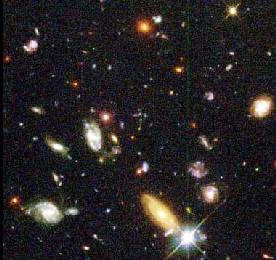 If the Universe has an infinite number of stars, why is the night sky dark?
If the Universe has an infinite number of stars, why is the night sky dark?
If you move the Sun twice as far away from us, we will intercept one-fourth as many photons, but the Sun will subtend one-fourth of the angular area. The intensity remains constant. With infinitely many stars, every angular element of the sky should have a star, and the entire heavens should be as bright as the sun.
This is Olber's paradox. It can be traced as far back as Kepler in 1610. It was re-discussed by Halley and Cheseaux in the eighteen century, and popularized as a paradox by Olber in the nineteenth century.
A few explanations:
- The Universe is of finite extent.
- The Universe is expanding, so distant stars are red-shifted into obscurity
(fluxes drop off faster than 1/R
2). - The Universe is of finite age. Distant light hasn't even reached us yet.
The first explanation may be true. The standard Big Bang cosmological model DOES include explanation two and three:
Because the universe is expanding, light works against the expansion to reach us from all directions, this ``cools'' or dims the light. It can't keep the entire Universe lit up.
We live inside a spherical shell of our "Observable Universe", where the radius equals the lifetime of the Universe. Objects more than about 15 billion years old are too far away for their light ever to reach us.